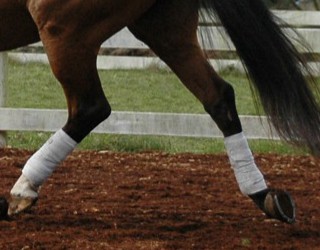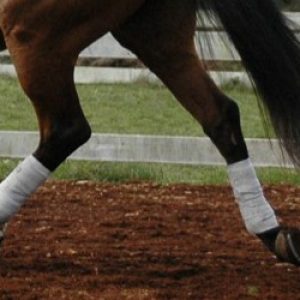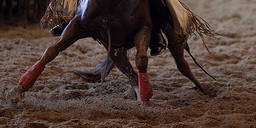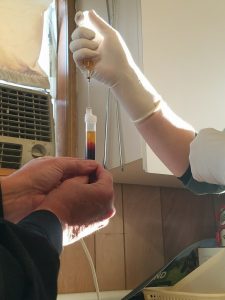

Arthritis is one of the most common joint diseases found in the equine industry. It is the leading factor of decreased performance and chronic lameness in our equine partners and is the source of much frustration and consternation. The insidious nature of the process means that we as horseman don’t always catch it in the early stages, and instead, are left dealing with the disease in more moderate to advanced situations. In a previous blog we’ve focused on how to prolong the onset of arthritis by using systemic nutraceutical or injectable products like Cosequin and Adequan (you can find that post here). This article will focus on the options available to us when these initial attempts against arthritis are no longer efficacious.
What happens during a joint injection?
Once our systemic therapies like Adequan and Legend have no longer proven to be effective in reducing joint pain associated with arthritis, we turn to localized treatment directly within the damaged joint. Prior to injecting any joints, your veterinarian will perform a thorough lameness exam to isolate the joint(s) from which the lameness is originating. From there, we as veterinarians prefer to obtain radiographs of the joint in question. This provides us both a baseline for future assessments as well as a better opportunity to understand any changes to the diseased joint that may alter our approach to needle placement. The information obtained from the radiograph enables us to give our clients a more accurate prognosis for both post-injection soundness and duration of efficacy of the injection.
Once you and your veterinarian have agreed to inject a joint(s), your veterinarian will then display an odd set of behaviors in which they tirelessly seek out the ideal location to perform an injection. The biggest risk associated with a joint injection is infection, so we tend to be pretty picky about when and how we inject. We avoid all windy situations, including drafts, as it seems just as you place the needle into the joint, a large gust of wind comes along and stirs up dust and debris which could potentially contaminate the joint. We also avoid injecting horses with wet mud/manure directly over and surrounding the site of injection. Clean, dry legs are necessary. We avoid areas of high traffic, as all it takes is an unknowing rider or the sneeze of a horse to contaminate our sterile site.
The ideal environment for a joint injection is one that has clean, dry footing (rubber mats or concrete work best), that is enclosed to restrict

or prevent airflow. Fewer birds in the overhead peanut gallery is also preferred! If these requirements cannot be found, don’t be surprised if your vet chooses to reschedule for a calmer/dryer day or you’re asked to relocate to a more ideal location. At the end of the day, a joint infection can be life altering so we strive to avoid those at all costs!
The injection process itself is also sterile. We will relocate all sources of potential contamination (tails, lead ropes, etc.) and will usually clip the injection site. All joint injections are preceded with a 12-minute sterile scrub, and all products used in the injection process are also sterile, including your vet’s gloves! Most practitioners will also use a small amount of antibiotic within the injection itself to further reduce the risk of infection.
What exactly is injected into the joint?
As mentioned before, there is a small amount of antibiotic that is included in every injection, but beyond that, there is significant variability. Larger volume joints (think coffin joints, knees, stifles, fetlocks) usually receive a high molecular weight hyaluronic acid (HA) and possibly steroids. The steroids work to decrease the pre-existing inflammation within the joint and the HA helps bring healthy components into the area to improve the overall joint environment. (There is also a mild anti-inflammatory response associated with HA). Lower volume joints (pastern joints and the lower hocks) usually just receive steroids and antibiotic, forgoing the HA due to the small volume of joint space available to accommodate the injection. There are several types of steroids available to use and which steroid we use is dependent on a multitude of factors. These include high vs low motion joints, age of horse, severity of the intraarticular disease process, and metabolic status of the horse. Steroids are contraindicated in horses with metabolic disorders which then has us reaching for an alternative – autogenous intraarticular therapies also termed “regenerative medicine.”
 Regenerative Medicine Therapies
Regenerative Medicine Therapies
For those horses with metabolic issues or who no longer respond well to intraarticular steroids, we now have a variety of options for use in their place. IRAP (interleukin-1 receptor antagonist protein), PRP (platelet rich plasma) and Prostride are all newer, autogenous technologies available to the veterinary industry. While PRP and ProStride have applications in horses with arthritis, IRAP is far and away the most commonly used.
IRAP is processed directly from your horse’s blood and it works to counteract the interleukin-1 (IL-1) inflammatory protein. The blood is collected into a special tube that is then incubated for several hours. During the incubation process, the IRAP molecule is amplified within the sample. After incubation, the sample is spun in a centrifuge which then separates the red blood cells from the IRAP rich plasma. The plasma is then divided up into small aliquots to be used during the joint injection process. Unlike steroids, which usually only require one injection to have a beneficial response, IRAP requires 2-3 injections, separated by 2 weeks in order to deliver similar results. The IRAP injections usually last an average of 6-8 months, but the duration of efficacy is dependent upon a multitude of factors and is different for every horse.
While arthritis can be a difficult condition to overcome, rest assured that we do have a large variety of therapeutic options to pursue. Please don’t hesitate to reach out with additional questions or concerns the next time you see one of us at your barn. We’re always happy to help you and your horse!








No comment yet, add your voice below!